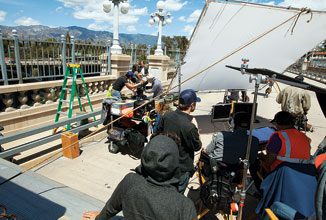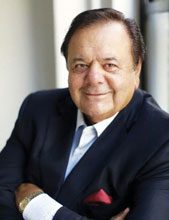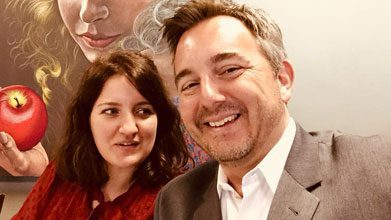 A cinematic conversation with Beaufort Filmmakers VW Scheich & Uyen Le
A cinematic conversation with Beaufort Filmmakers VW Scheich & Uyen Le
By Mark Shaffer, Features Editor
FADE IN
INT. PRIVATE SCREENING ROOM – NIGHT
ON SCREEN the credits roll for a film titled INTERWOVEN. It’s shaky grainy stuff obviously BOOTLEGGED footage.
The theater’s empty save for two FIGURES, one FAT and one THIN – sitting several rows apart in the back of the house SILHOUETTED against the flickering light from the projector. The fat man in the back puffs a cigar. Blue plumes of smoke drift through the light. The thin man sports a fedora and flips open a notebook.
CIGAR MAN
Impressive. Let’s get to it. Time is money and I’m short of both. What’s the skinny?
HAT MAN
(Flipping through notes)
The picture’s “Interwoven.” First feature from Rareform Pictures, husband and wife team – VW Scheich and Uyen Le. Relocated from L.A. to Beaufort last year. He’s got a background in big budget visual effects. She’s an entertainment attorney.
The fat man GRUNTS.
HAT MAN
This Beaufort International Film Festival seems key. Lots of buzz. These two won the short film a few years back and made a connection with…
(Pauses and looks up)
Weeks.
CIGAR MAN
(Pounds chair)
GARY Weeks? Blast the man! He’s ubiquitous!
HAT MAN
(Clears throat)
These three got a picture in the pipeline – one of Weeks’. Feature comedy called “Basement Bob” set to shoot in Beaufort. It would mean the return of movies to the Lowcountry.
TIGHT on Cigar Man’s fat FINGERS as they drum the arm of the chair.
CIGAR MAN
So, that’s the game, eh? Pretend you’re a writer from some local rag out for an interview. They eat that stuff up. Can’t resist. I need to know what they’re capable of.
HAT MAN (folding notebook)
Sure thing, boss. Whatever you say…
INT. AN APARTMENT – DAY
Hat Man posing as a WRITER sits with his BACK to CAMERA, pad and pen visible facing the filmmakers. A TIGER leaps from a giant CIRCUS POSTER plastered across the entire wall behind them.
WRITER: Structurally, this isn’t like anything else I can recall. How did you go about developing and nurturing it?
VW Scheich (below): When you’re an independent filmmaker it’s a daunting task because you have all these BIG movie ideas and no big movie funding. It’s a little discouraging. The reality is that you go to theater and see these movies that you you don’t like and you think, Gosh if I had fifty million dollars I would do blah, blah blah.

Uyen Le: Or even if we had one tenth of that budget!
VW: You get very disgruntled, right? Eventually I got to a place where I can work on these big movies as part of the crew, but how am I going to make my own movie? I sort of slipped into this funk. Uyen was off on a retreat and I was sitting at home and I watched this documentary series on Netflix called “The Story of Film.” I’m watching these old filmmakers making movies with no color, no sound, no digital effects, and they still hold up today. I found it very inspiring. I took this to heart and thought that if I’m going to follow these legendary filmmakers – names I remember from film school – what do I have to work with? What are my assets? Because I can get so far along in the production process and then I just need money.
But what if money is no object, because we don’t have any and what if we reverse engineer the whole thing? And that’s where I came up with the idea. What we have are a lot of actors and there’s a lot of talent in Hollywood. That began the process.
if we reverse engineer the whole thing? And that’s where I came up with the idea. What we have are a lot of actors and there’s a lot of talent in Hollywood. That began the process.
UYEN: He came to me and said, “Uyen, we live in L.A. we have access to all these actors and a lot of them would love to be involved in a feature film. So what if instead of writing the script first, we put out a casting call for all ethnicities and interview people about their interesting life stories and make a film around that?”
VW: We have a friend who’s a casting director who helped [set up the process] and we got 2011 submissions.
WRITER: And each one’s coming in with a story?
VW: They didn’t know that. I just posted: Feature film shooting in Los Angeles. Paid. Union/Non-Union. Male, female, tall, short, heavy, thin –
UYEN: All ages, all ethnicities.
VW: It was a “come one, come all who walk or crawl” sort of thing. Everybody wanted to be in the movie, which was great. It’s what you need if you’re making an indie film. Through all the hardships, you’ve got to have people who are going to give it their all, otherwise there’s no reason to do it.
UYEN: VW culled through all the 2011 submissions and headshots looking for faces that looked interesting –
VW: That looked striking – the ones that jumped out at me. I got it down to 75 people. And then we did casting sessions, but they were actually more like therapy sessions.
The actors would come in and want a character breakdown and some script pages but I didn’t have any of that because I didn’t have a story, didn’t have a screenplay.
So, I broke it down and explained the process. A lot of them were surprised. They’d never had the opportunity to talk to a director  and sit down and really go through the moments. No one does it. You walk in, talk to a camera, read a few lines once, twice if you’re lucky and it’s, “Thank you. Next!” I told them I wanted to base some of my characters on some of their experiences. So, what’s your story? You were born and what happened next? (Laughs)
and sit down and really go through the moments. No one does it. You walk in, talk to a camera, read a few lines once, twice if you’re lucky and it’s, “Thank you. Next!” I told them I wanted to base some of my characters on some of their experiences. So, what’s your story? You were born and what happened next? (Laughs)
I asked leading questions to see if they’d follow me. And if they became abrasive I knew I couldn’t direct them. If I can’t direct you in a conversation, I surely can’t direct you in a scene for a day. So there were little tests, some push and pull to see if they got my sense of humor, because I’m very funny. I don’t know if you know this.
WRITER: There are rumors.
UYEN: Ultimately he wanted them to describe a moment or an event in their lives that changed them irrevocably.
VW: It was three weeks of casting, casting, casting, all day long. The people at this facility who were letting me use the space for free finally said, “This is waaaaay too many people coming through here.” I outstayed my welcome.
NOTES: And then Myles Cranford walks through the door. The actor’s deeply personal story of being homeless on the streets of L.A. served as the basis for the body of the film. Cranford’s Otis is the narrative nucleus around which all the individual stories meet and connect, if only for a moment.
VW: Ultimately his story is how he found and became one with God and things started working out for him after he has this epiphany. It’s a great story. After we screened the film at the Mill Valley Film Festival we all go out to celebrate and this Little Caesar’s commercial comes on the TV over the bar and there’s Myles!
UYEN: One by one VW began to see how the stories that really captivated him could interact. We began to toy with the idea that there are so many people that you see every day of your life and you never speak to them or get to know them and , yet, at one point every friend was a stranger. We became fascinated with how human connections work, how people can play a large or small role in your life and you may never really know how it all plays out.
, yet, at one point every friend was a stranger. We became fascinated with how human connections work, how people can play a large or small role in your life and you may never really know how it all plays out.
WRITER: So now you’ve got these puzzle pieces. The question is how to put them together?
VW: Right. A friend told me a story about his mom. She’s in her late 90’s on her deathbed and she looks him in the eyes and says, “What does it mean? What’s it all about?” And she dies. So I thought what if we do a movie where we took everyone’s moments that seem very important to them and just put them out there and in the end we’ll let the audience decide what it’s all about. Which is where the original title of the film – “About” – came from. But that’s so vague. When we were meeting with Mo’Nique and her husband & manager they suggested “Interwoven.”
WRITER: Is there something from your own lives that motivated you to make this either consciously or subconsciously?
UYEN: I think VW was at a point where he needed to direct a feature film, and the central question he had was, “Who will trust me with the money to direct this film?” It’s a big leap from shorts to features. So, I said WE will trust you. We WILL make it happen. It was a response to the question, “Are you going to do what you believe you’re born to do or not?”
VW: It’s pretty simple: if you’re not making films you’re not a filmmaker. Uyen believes in me so much, she just said, “Put your film together.”
NOTES: The short version is that’s exactly what they did, but in a way pretty unique to Hollywood. Once the casting was complete, the script was distilled from the mash of the actors’ own stories – although not all of the stories are portrayed by their original source. Mo’Nique, winner of the Best Supporting Actress Oscar for 2009’s “Precious,” stepped in to play a particularly difficult part. While an Oscar winner adds a certain cachet to the film, Scheich says he didn’t want to put the original source through that sort of pain again. Apart from their stories, many of the actors also provided a location in which to shoot it – in many cases the location in which the actual story took place. Another piece of the puzzle solved.
Scheich’s specialty is visual effects. His recent credits include prestige small screen hits like FX’s “Fargo” and the Netflix smash “House of Cards.” Recent big budget, big screen projects include Dwayne Johnson’s “Hercules,” the Oscar winning “American Hustle,” and the epic re-make of “Ben Hur.”
To prep for “Interwoven, Scheich pre-shot most of the film on his smart phone. This was processed into a 3-D animatic that allowed the filmmakers to virtually tweak every detail long before the crew got on set. This along with meticulous planning and scheduling also meant that every cent ended up where it belongs – on screen. Nothing was left to chance. Production lasted a scant 15 days, wrapping early on most.
WRITER: I’ve heard this described as a “faith-based film.” Having seen it, I can understand why, although I’d say the content might shake up the usual faith-based audience. And you don’t strike me as particularly religious types.
 UYEN (left, with Scheich & BIFF filmmaker Gary Weeks): Well, we had to have faith in ourselves to actually make the film.
UYEN (left, with Scheich & BIFF filmmaker Gary Weeks): Well, we had to have faith in ourselves to actually make the film.
(Laughs)
VW: So it is a faith-based film in that regard.
UYEN: No one incident triggered the need to make this movie, but we were dealing with some doubt about whether we were moving in the right direction. I think that may have played itself out in the need to believe and have faith in ourselves.
VW: As far as not being very religious, obviously you know us pretty well. You couldn’t be more right. That’s not us. But I think you have to have a little faith in yourself and that’s the idea that makes [“Interwoven”] palatable as a faith-based film for every person.
We didn’t set out to make a faith-based film, but Myles’ story worked so well.
WRITER: Is this an experimental film?
VW: I think the heart of experimental filmmaking is in this. It’s not traditional.
UYEN: It can’t be replicated.
VW: One thing I would say to viewers who are going to come watch this movie, if they allow us to have them throw away all of their pre-conceived notions of what they think a movie should be – this isn’t about the hero that fights the dragon and saves the princess. This is a film that shows you that we don’t really know who’s coming in and out of our lives. Perhaps they’re there for half a second during a fender bender and then they’re gone forever, but after that you drive a little safer, right? So you affect somebody, but you don’t know how. That’s kind of neat.
DISSOLVE TO:
INT. SAME APARTMENT – LATER
ON THE TV SCREEN we pick up the same credits we saw in the projection room.
TIGHT on the WRITER’S PAD as the ink from the final stroke of the fountain pen dries. It reads:
Smart, economic filmmaking steeped with a raw, detached intensity that slips the viewer into the role of voyeur. Some of it is about choice; some about letting go and some of it is about coping with a world spinning out of control. All of it is about existential questions we either deal with, or we don’t, and the consequences born of those decisions. In the end, all is interwoven.
FADE TO BLACK
“Interwoven” screens at BIFF 4:15 Thursday Feb 11th.
Coming soon to LowcountryWeekly.com: What About (Basement) Bob?







